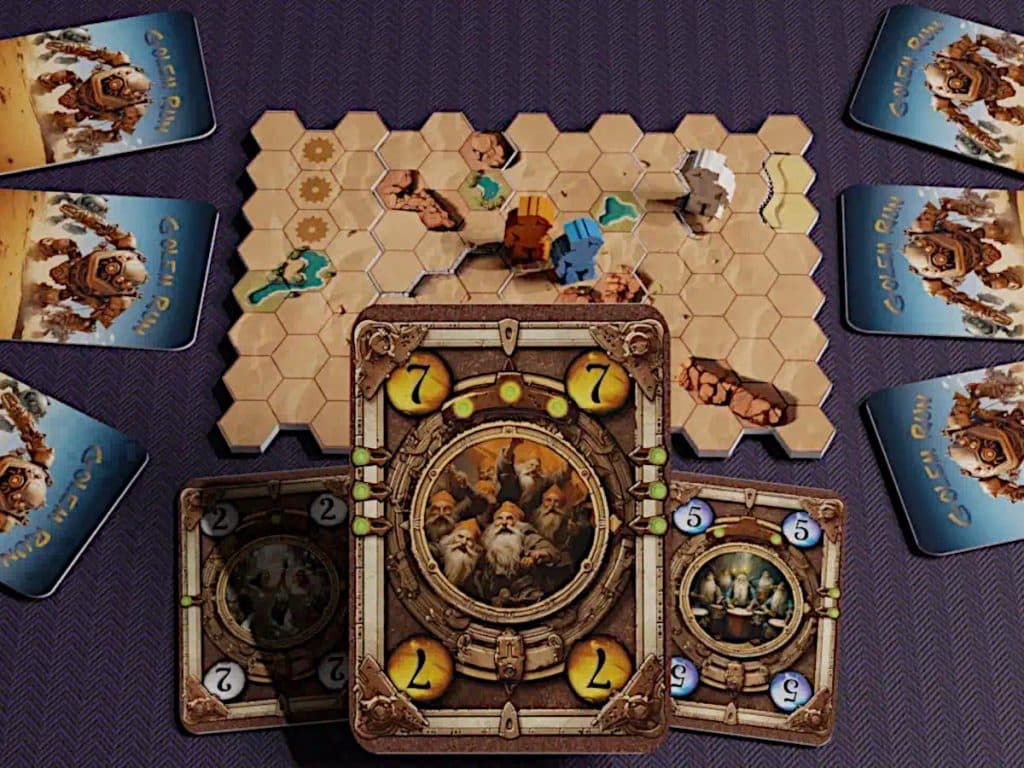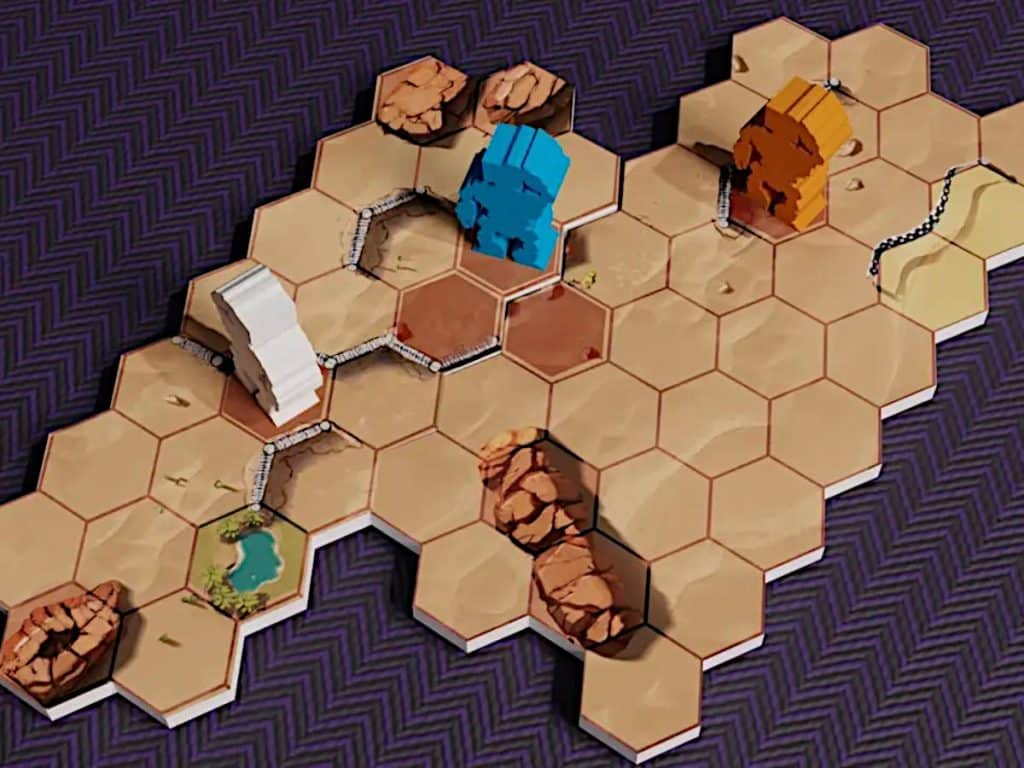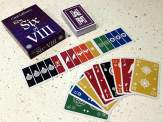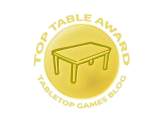| Release Date: 2025 | Players: 3-5 |
| Designer: Ren Multamäki, Tony Cotterill | Length: 30-45 minutes |
| Artist: n/a | Age: 12+ |
| Publisher: Dragon Dawn Productions | Complexity: 2.5 / 5 |
| Plastic (by weight): <1% | Air (by volume): 25% |
In a distant future, giant clay figures are pitted against each other in a race through a desolate terrain. They are controlled by racers who have secretly bet on a specific creature to cross the finish line first. However, all racers have control over all of the creatures and can change their bets during the race. The locals call this chaotic contest Golem Run by Tony Cotterill and Ren Multamäki from Dragon Dawn Productions.
Listen to the Audio Version
Intro Music: Bomber (Sting) by Riot (https://www.
“Liberty Quest” by Sascha Ende
Link: https://filmmusic.
License: https://filmmusic.
Golem Run is centred around a modular race track, which is built in a sort of draft during setup, and three golems that are controlled by the players. At the beginning of the game, everyone secretly bets on one of the golems to win the race. So far it sounds like a pretty standard racing game. However, what makes this game different and what first attracted me to it is that it uses trick-taking to decide which golem moves and how far it travels. That’s not something I’ve seen before.
Trick-taking is a mechanism I love. It has had a big renaissance recently and there are a lot of trick-taking games on the market that offer some interesting twists to the traditional way of playing these card games. There have also been a number of attempts by board games to incorporate trick-taking as one mechanism amongst many others, with Arcs being the most recent example I can think of and Brian Boru an earlier one. So seeing another contender got me excited.
Golems Running
The cards in Golem Run come in four different colours and are numbered 2 to 9. However, the distribution of these cards isn’t equal across the suits. Additionally, one of the suits, black, is a wildcard colour and will eventually be declared to represent one of the other three suits, which match the colours of the three golems. On each card is also a number of so-called movement dots, which decide how far a golem moves. To make a golem move, you need to win the trick, because it’s the colour of the winning card that defines which golem moves and the movement dots on the card say how many steps it moves.
Now that you have the last piece in the puzzle, you need to bet on a winner. Unfortunately, you only have your own hand of cards to go on. You don’t have the full picture, because not all cards were dealt out, which means you don’t know what other players have.
Betting on the winning golem is a tough decision to make and I think you really need to be an experienced trick-taking player to make it. Otherwise, you will struggle. After all, the game is designed around trick-taking.
However, as a seasoned trick-taking player I was really excited by Golem Run. I could foresee how a clever play of your cards could ensure your golem wins the race. I was imagining how the tricks of classic trick-taking games could be applied to outmanoeuvre your opponents even if you had a bad hand.
Unfortunately, Golem Run didn’t quite deliver on my hopes and expectations and here are the reasons why.

Golems on the Move
My first issue is the movement potential available on the cards everyone is dealt. A single hand will definitely not finish the race. You will play at least two hands, if not more.

Get yourself a wooden Tabletop Games Blog dice tray.
Each tray is the perfect size to roll your dice, and with the soft mat, it’s really quiet, while the wooden frame makes it wonderfully sturdy.
So let’s assume your first hand allows you to put the golem you bet on to get way ahead, but your second hand favours a different golem. Now you have a bit of a problem.
Of course, as a seasoned trick-taking player you can intentionally lose tricks and hope that someone else has bet on the same golem as you and that they will move it forward. Unfortunately, if someone else bets on the same golem as you, they will score the same points as you. While in a 4 or 5-player game, that is unavoidable, it’s still not something you want to have to rely on. Golem Run is not a team game, after all.
Of course, the game has tried to address my concern. Each hand is a mini-scoring round, where everyone reveals their bets and gets points if they win their bet. Everyone then gets a new hand of cards and places new bets.
As I said earlier, your second hand will most likely favour one of the golems at the back. Yet, betting on one of those golems may be too much of a risk if the lead golem is too far ahead. Of course, you can bet on the leading golem again and hope someone else keeps it in the lead, while you lose tricks intentionally.
I guess it works, but it feels a bit chaotic and dilutes the trick-taking mechanism for me. A race using a single hand would have made Golem Run a lot more exciting in my view.
Tricky Golems
The other problem I have with the game is the booster cards. On top of the cards numbered 2 to 9, each suit also has a certain number of modifier cards that you play alongside a base card, increasing the base card’s value by 1 for each booster card of the same suit that you have played.
That in itself isn’t an issue, but given that you can’t play booster cards on their own, it means, the more booster cards you have in your hand, the fewer tricks you are able to take part in, because you’re just going to run out of base cards before everyone else.
Also, if a booster card colour doesn’t match any of your base cards, you can’t play it. So if you’re really unlucky, not only do you have fewer cards to win tricks with, but you also have a number of cards that are absolutely useless to you.
That is my biggest problem with Golem Run. There is nothing you can do about boosters. You’re stuck with boosters that potentially pollute your hand with pointless cards.
It would have been more interesting if boosters could be played on their own instead of a value 1 card maybe, as well as used to boost base cards. That way they would at least be of some use when you don’t have base cards of matching colours.

Golem Betting
The last issue, while being my smallest niggle, are the so-called side bets. I get why you want to bet on the golem that you think will win or at least be the leading golem in a round. At least you have some information to help you make an educated guess.
However, in Golem Run, you also need to place a bet on who you think the player to your left and the player to your right have bet on. So you make a total of three bets: one that you can at least try and guess, while the other two are almost random choices. You have no idea if your neighbours bet on the lead golem or one of the other two. You don’t know what cards they have. So you can really only make a stab in the dark.
While I can see that the extra two bets may be about introducing a certain element of social deduction, it doesn’t work for me. It seems really pointless.
The only redeeming factor is that in Golem Run, you can sit out a trick and change your bets instead. It’s a way of stashing some potentially useful cards in your bets and retrieving them when it becomes a bit clearer as to what golem your neighbours might have bet on.
Changing your bet does mean that you forego taking part in a trick and influencing the race. However, that might not be a bad thing, if you have a lot of boosters. It keeps you in the race for another trick and might give you the opportunity to win a decisive trick to fulfil your newly placed bets later in the game.
Despite all that, it doesn’t quite work for me. The side bets are a step too far in my view.
Golem Run to the Finish
Saying all of that, I can see that certain game groups will love the chaos of Golem Run. The modular track, which you build at the start and which is divided into hexes showing different terrain, some of which is impassable, is neat and certainly provides a lot of variability. Being able to change your bets during a race will certainly create a lot of chaos.
Yet, for me, Golem Run was a different game in my head: a game where trick-taking was a means to influence a race through clever card play. As it stands, the trick-taking in this game is not front and centre where it should be. With a few more tweaks and changes, the game can be something stronger and much more interesting. It’s certainly a strong contender and has everything a true racing athlete needs, but for me, it just missed the podium.
This blog is free for everyone, but if you'd like to support it, here are some options.
Useful Links
- Golem Run: https://www.
kickstarter. com/ projects/ ddpgames/ golem-run-race-bet-fix-and-win? ref= ehk9ci - Rulebook: https://www.
dropbox. com/ scl/ fi/ 5voy05gu0r34sqqcyl2az/ Golem-Run-Rulebook-EN-WEB. pdf? rlkey= 2m0rqvftmn44utukiy2remf0s& amp;dl=0 - Dragon Dawn Productions: https://www.
ddpgames. com/ - BGG listing: https://boardgamegeek.
com/ boardgame/ 411938/ golem-run - Arcs review: https://tabletopgamesblog.
com/ 2024/ 11/ 02/ arcs-saturday-review/ - Brian Boru review: https://tabletopgamesblog.
com/ 2022/ 04/ 16/ brian-boru-high-king-of-ireland-saturday-review/
Transparency Facts
I feel that this review reflects my own, independent and honest opinion, but the facts below allow you to decide whether you think that I was influenced in any way. Please also read my Ethics Statement for more information.- I was given a free review copy of this game by the publisher.
- At the time of writing, I have not received financial support from the publisher or anyone working on their behalf.
Audio Version
Intro Music: Bomber (Sting) by Riot (https://www.
“Liberty Quest” by Sascha Ende
Link: https://filmmusic.
License: https://filmmusic.
Playlist
These are the songs I listened to while I was writing this review:





